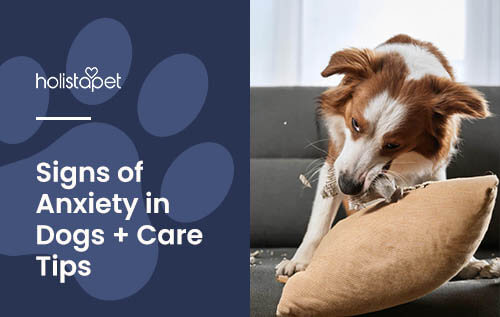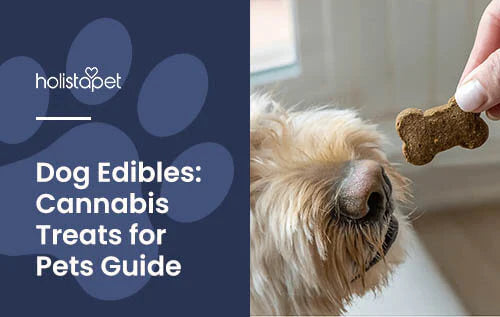Don't let canine anxiety steal your pup's joy. Identifying the signs of anxiety in dogs is the first step in helping your anxious dog cope with life's challenges.
Pet parents worried about their dogs' anxiety should read our handy guide. We'll walk you through the indicators and causes of dog anxiety. We'll also explain how managing anxiety can help your four-legged friend achieve emotional balance and good health. Let's begin!
What Is Dog Anxiety and Is It Common?

Dog anxiety happens when dogs exhibit nervous behaviors in response to stressors. It can manifest in different ways and affect pups of all breeds and ages. Anxiety in dogs is common and can arise from many factors. Think loud sounds, changes in routine, or separation from their favorite person.
Many dogs experience anxiety, and their owners must recognize the symptoms early. If left untreated, anxious behaviors can snowball into chronic anxiety and other behavior problems.
Importance of Addressing a Dog's Anxiety
Anxiety disorder can affect a dog's quality of life. It can lead to behavioral issues such as destructive behavior and aggression. These can be challenging for dog owners to manage.
Untreated anxiety can also affect a dog's health. Issues like weight loss and gastrointestinal problems can arise. To prevent these problems, promptly recognize and address your dog's symptoms. Doing so can bring both you and your pup security and harmony.
What Are the Common Signs of Anxiety Issues in Dogs?
Dog anxiety can manifest through various symptoms. We can generally categorize them into three main areas: behavior, body language, and physical health. Spotting these red flags is the first step in helping your dog cope with anxiety and return to normal behaviors.
Behavioral Signs of Dog Anxiety
Dogs often show distress through behavioral changes. Be wary if your dog shows signs such as:
- Excessive Barking, Howling, or Whining. An anxious dog may vocalize more to express discomfort.
- Excessive Licking or Self-Grooming. Dogs might excessively lick or groom themselves, causing bald spots or skin irritation.
- Aggression. Anxiety can lead to aggression towards people or other dogs, including growling, snapping, or biting.
- Destructive Behaviors. Chewing furniture and digging can mean that a dog is anxious.
- Restlessness and Pacing. Most dogs can't settle down when feeling anxious.
- Hiding. Seeking out small, secluded spaces to hide is an example of anxious behavior.
- Clinginess. Anxious dogs may become very clingy.
- Potty Accidents. Even house-trained pups can have accidents indoors when distressed.
Body Language Cues of Dog Anxiety
A dog's body language can give clues about their mood. Your pet may be nervous or upset when they show:
- Frequent Yawning and Lip Licking. These can mean your pet is in distress.
- Trembling or Shaking. Shaking or trembling, even when it's not cold, can point to anxiety.
- Tail Tucking. A scared or anxious dog might tuck their tail between their legs.
- Teeth Baring. Showing teeth without growling can be a sign of discomfort or fear.
- Dilated Pupils. Enlarged pupils can point to a dog's anxiety.
- Whale Eye. When a dog shows the whites of their eyes, it can mean fear or distress.
- Flattened Ears. Ears pinned back against the head often imply anxiety.
- Hunched Posture or Tightly Curled Body. A tense, hunched posture or curling up tightly can mean an anxious dog.
Physical Health Symptoms of Dog Anxiety
A dog with anxiety disorder may also show physical symptoms. Your pup will need help if you notice:
- Panting and Rapid Heart Rate. Anxious dogs may pant excessively and have a rapid heart rate even when not active.
- Excessive Drooling. Increased drooling can be a sign your pet is nervous or upset.
- Loss of Appetite (Causing Weight Loss). Anxiety can make a dog feel disinterested in food, resulting in weight loss over time.
- Gastrointestinal Issues. Anxious dogs may experience stomach upset, diarrhea, or vomiting.
What Are the Most Common Causes of Dog Anxiety?
Dog anxiety can come from various factors. Not all dogs will have the same triggers. Some common causes include separation anxiety, lack of socialization, past trauma, and underlying medical issues.
Separation Anxiety

When a dog has separation anxiety, they may feel distressed when left alone or separated from their favorite person. This can lead to destructive behaviors such as chewing furniture or scratching doors. Anxious pups may also excessively bark and have potty accidents.
Slowly get your dog used to being alone. To start, leave them for short periods and gradually increase the duration. Plenty of physical and mental stimulation, interactive toys, and a safe space can also help.
Loud Noises
Thunderstorms, fireworks, or even vacuum cleaners can trigger anxiety in many dogs. They may start trembling, shaking, hiding, excessively barking, or trying to escape. Some dogs may also pant or drool a lot.
Create a safe and quiet space for your dog to retreat to during loud events. Calming aids and soothing music might help, too.
Resource Guarding
Some pups may become aggressive about protecting their possessions or favorite people. This resource-guarding behavior is often driven by the fear of losing what they value. Indicators include growling, snapping, or biting when someone approaches the guarded object or person.
Practice behavior modification techniques, such as positive reinforcement training. By rewarding your pet's calm behavior, you can get them used to people approaching their guarded items. You can also work with a dog trainer or veterinary behaviorist.
Lack of Socialization
Behavioral issues can arise when dogs lack exposure to different people, animals, or environments during their early years. Their anxiety can manifest as trembling, hiding, excessive barking, avoiding interactions, and aggression.
Slowly introduce your pet to new experiences and environments in a controlled manner. Using rewards can help build their confidence. Socializing your dog with calm, friendly animals can do wonders, too.
Past Trauma
Abuse or neglect can lead to long-term anxiety. Affected dogs may show nervous behaviors in triggering situations. Common clues include cowering, trembling, hiding, aggression, and avoiding certain people, places, or objects.
Provide a stable and loving environment for your traumatized dog. Use gentle, positive reinforcement. Patience is key, as it may take time for your pup to build trust.
Changes in Routine or Environment

Moving houses, schedule changes, or a new pet can cause dogs stress. They may bark excessively, destroy objects, have accidents, or refuse to eat. They may also either become withdrawn or clingy.
Try to maintain as much of the old routine and environment as possible. Gradually introduce changes. Also, give your dog plenty of reassurance to help ease the transition.
Genetics and Breed Disposition
Certain breeds, such as German Shepherds, Border Collies, and Cocker Spaniels, are more prone to anxiety disorders due to their genetics. They are naturally high in energy and sensitive to environmental changes. They may exhibit over-vocalization, restlessness, destructive behavior, and aggression when anxious.
Provide them with lots of physical and mental exercise and use positive reinforcement. Creating a stable environment and consulting a veterinary behaviorist can also help.
Underlying Medical Conditions
Medical issues, such as thyroid disorders and chronic discomfort, can contribute to anxious behaviors. Cognitive dysfunction syndrome, which affects senior dogs, can also increase anxiety. Affected pups may show irritability, aggression, or withdrawal. Other symptoms include excessive panting, drooling, and weight loss.
A veterinarian can diagnose and treat the underlying issue. In some cases, they may prescribed anti-anxiety medication to help manage the symptoms.
Potential Preventative Measures
Preventing anxiety requires smart strategies to help reduce your dog's stressors. Here are some helpful tips:
- Keep a Regular Routine. Consistent activities help dogs feel more secure and less anxious.
- Build Their Confidence. Rewards and socialization can help boost a dog's confidence and reduce worries.
- Provide Physical and Mental Stimulation. Regular exercise and interactive toys can help keep your dog engaged.
- Try CBD and Melatonin for Dogs. CBD (cannabidiol) has calming properties that may help ease dogs' anxiety. CBD interacts with the canine endocannabinoid system (ECS), which plays a role in regulating sleep, mood, and stress response. Meanwhile, melatonin acts like a switch that tells the body when it's time to sleep and wake up. For your furry friend, we recommend HolistaPet's:
- CBD Oil for Dogs, CBD Dog Treats for Anxiety, and CBD Calming Chews for Dogs. These products use high-quality, broad-spectrum CBD with no THC (tetrahydrocannabinol), the mind-altering compound in cannabis. Our offerings promote relaxation without the risk of unwanted effects.
- Melatonin for Dogs. Each soft chew contains a proprietary blend of calming ingredients, including L-theanine, chamomile, passion flower, ashwagandha, tryptophan, and valerian root. These double as treats while easing anxiousness and promoting better sleep.
- Remove or Manage Anxiety Triggers. Identify and reduce triggers that cause anxiety in your dog.
- See Your Veterinarian Regularly. Checkups can help detect and address any underlying health issues that might contribute to your dog's anxiety.
How to Provide Comfort to Anxious Dogs
Dog owners will do anything to comfort their anxious pets. Here are some ways you can help your dog feel better:
- Spend Time With Your Dog. Regular quality time can help reduce dog anxiety.
- Try CBD and Melatonin for Dogs. HolistaPet's range of CBD products and our melatonin supplement may help bring calm and comfort to your anxious pup. Our all-natural products are gluten-free, dairy-free, non-GMO, third-party lab-tested, and vet-approved for the best support.
- Provide Your Dog With a Safe Space. Assign an area where your dog can retreat to feel safe and secure when distressed.
- Use Positive Reinforcement Training. Rewarding your dog for calm behavior helps reinforce a sense of security.
When Should I Bring My Dog To See a Veterinary Behaviorist?
If your dog's anxiety persists despite your efforts, consult a veterinary behaviorist. These professionals specialize in diagnosing and treating behavioral issues in pets. They can create a treatment plan, which may include behavior modification techniques and, if needed, anti-anxiety medications.
Final Thoughts - Signs of Anxiety in Dogs
We talked about the common symptoms and causes of dog anxiety. And with the tips we gave, you're on the right path to keeping your pup calm and relaxed. For more support, give our CBD and melatonin dog products a try. Remember, addressing anxiety early can lead to a healthier, happier life for your best friend! View more blogs about dog care here.







![Probiotics For Dogs [Soft Chews] - HolistaPet](http://www.holistapet.com/cdn/shop/files/Probiotic-Infographic-1_472d7a29-e30c-435a-9638-1365d8c3a9f9.jpg?v=1725384841&width=104)




























Leave a comment
All comments are moderated before being published.
This site is protected by hCaptcha and the hCaptcha Privacy Policy and Terms of Service apply.